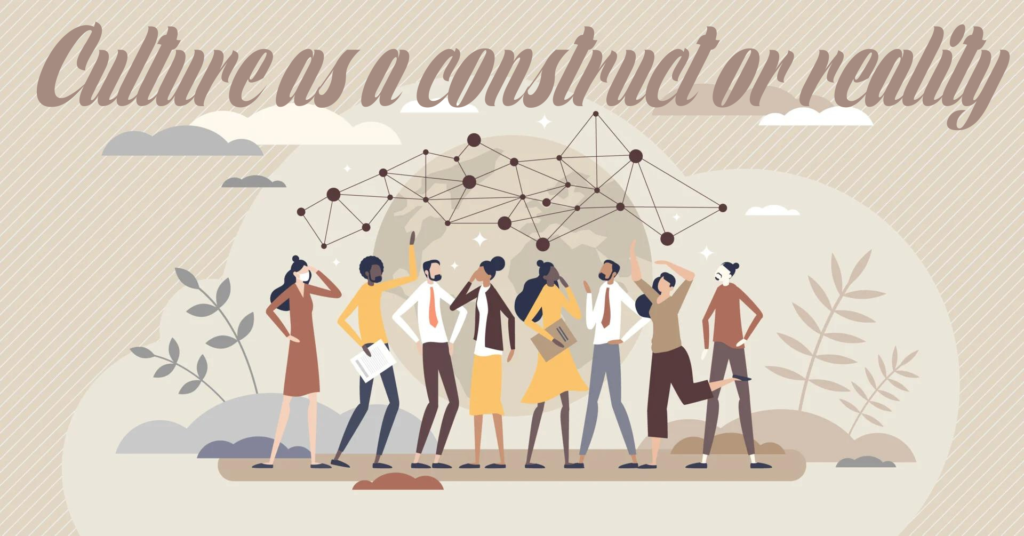In anthropology, the debate over whether Culture as Construct or a reality revolves around how scholars conceptualize and study cultural phenomena. This dichotomy explores whether culture is an objective entity that exists independently of human perception and interpretation (reality) or a conceptual framework created by anthropologists to understand human behavior and social practices (construct). Here’s an exploration of both perspectives, key proponents, and examples:

Culture as Construct
Definition: In the constructivist view, culture is seen as a conceptual framework or theoretical construct created by anthropologists and other social scientists to analyze and interpret human behavior, beliefs, and social practices. Culture is understood as a tool or model that helps make sense of the complexities of social life.
Key Points:
- Anthropologist’s Perspective: Culture is approached as a theoretical concept used to organize and interpret empirical data collected through fieldwork.
- Interpretive Tool: Provides a framework for understanding how social norms, beliefs, values, and practices are learned, shared, and transmitted within societies.
- Subject to Change: Recognizes that cultural categories and boundaries may shift over time and across different contexts.
Proponents:
- Clifford Geertz: Geertz’s interpretive anthropology emphasizes the role of culture as a system of symbols and meanings that individuals use to interpret their experiences and social interactions.
- Victor Turner: Turner’s work on symbolic anthropology focuses on rituals and cultural performances as symbolic processes that shape social identities and collective beliefs.
Examples:
- Symbolic Interpretations:
- Example: The interpretation of religious rituals or artistic expressions as symbolic acts that convey deeper cultural meanings and social values.
- Case Study: Geertz’s study of Balinese cockfighting illustrates how a seemingly trivial cultural practice serves as a symbolic representation of social status, masculinity, and community solidarity.
- Cultural Symbols and Meanings:
- Example: The analysis of cultural symbols, myths, and narratives to understand how they reflect and shape cultural identities and collective memory.
- Case Study: Turner’s study of Ndembu rituals in Zambia demonstrates how ritual performances symbolically mediate social conflicts, transitions, and transformations within the community.
Culture as Reality
Definition: In the realist perspective, culture is viewed as an objective and tangible reality that exists independently of individual perceptions or interpretations. Culture is seen as a set of tangible social practices, beliefs, and artifacts that shape and constrain human behavior within societies.
Key Points:
- Empirical Foundation: Emphasizes the observable manifestations of culture, including material artifacts, rituals, customs, and social institutions.
- Structural Analysis: Focuses on how cultural patterns and norms structure social interactions, relationships, and institutions.
- Persistent and Enduring: Recognizes culture as a dynamic yet enduring force that shapes social life across generations and historical periods.
Proponents:
- Marvin Harris: Harris’s cultural materialism argues that cultural practices and beliefs are shaped by material conditions and ecological factors, emphasizing the empirical study of cultural practices.
- Bronislaw Malinowski: Malinowski’s functionalist approach explores how cultural practices fulfill specific social functions and needs within societies.
Examples:
- Material Culture and Technology:
- Example: The analysis of tools, technologies, and material artifacts to understand how they reflect and shape cultural practices and social organization.
- Case Study: Harris’s study of the role of cattle in Hindu society illustrates how economic practices, religious beliefs, and ecological conditions are intertwined in cultural systems.
- Social Institutions and Organizational Structures:
- Example: The study of kinship systems, political institutions, and economic organizations as structural components of culture.
- Case Study: Malinowski’s ethnographic research among the Trobriand Islanders demonstrated how kinship, marriage customs, and economic exchange systems are integral to social cohesion and community organization.
Synthesizing Perspectives
Anthropologists often integrate elements of both constructivist and realist perspectives in their studies of culture, recognizing the dynamic interplay between theoretical frameworks and empirical realities. By considering culture as both a conceptual tool for interpretation and an observable set of social practices, anthropologists gain a more comprehensive understanding of how cultural diversity shapes human societies worldwide.
Conclusion
The debate over whether culture is a construct or a reality underscores the complexity and multi-dimensional nature of cultural anthropology. While constructivist perspectives highlight the interpretive and symbolic dimensions of culture, realist perspectives emphasize the empirical study of cultural practices and social structures. Both perspectives contribute to a nuanced understanding of how culture influences and shapes human behavior, social relationships, and collective identities across different societies and historical contexts.
